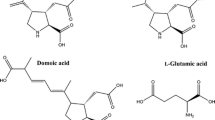Abstract
The permeability of the blood-brain barrier to glutamate was measured by quantitative autoradiography in brains of 7-day-old rats (average plasma glutamate 114 μM) and rats injected subcutaneously with glutamate (average plasma glutamate 2,670 μM). Measurements of glutamate permeability were initiated by the injection of [14C]glutamate into the inferior vena cava and the 7-day-old rats sacrificed at 1 minute to avoid the accumulation of [14C]glutamate metabolites in plasma. Glutamate entered the brain at a slow rate, with an average permeability-surface area product of 12 μl⊙min−1⊙g−1, except in those areas known to have fenestrated capillaries. Thus, glutamate readily entered and accumulated in circumventricular organs where the radioactivity was localized. Although three areas with a blood-brain barrier, the cerebral cortex, the hypothalamus and the midbrain, of 7-day-old rats had permeabilities similar to adult rats, the other areas of the brain with a, blood-brain barrier had a permeability about 1.5–1.9 times that of adult rats. The greater permeability of the brain of 7-day-odl rats may reflect the degree of immaturity of the blood-brain barrier.
Similar content being viewed by others
References
Bernt, E. and Bergmeyer, H. (1974). L-glutamate: UV-assay with glutamate dehydrogenase and NAD. In (H.U. Bergmeyer, ed.),Methods of Enzymatic Analysis, Academic Press, New York, pp. 1704–1708.
Bradbury, M. (1979)The Concept of a Blood-brain Barrier, John Wiley & Sons, New York.
Brightman, M. N. and Broadwell, R. D. (1976). The morphological approach to the study of normal and abnormal brain permeability.Adv. Exp. Med. Biol. 69:41–54.
Broadwell, R.D., Balin, B.J. and Cataldo, A.M. (1987). Fine structure and cytochemistry of the mammalian median eminence. In (P.M. Gross, ed.),Circumventicular Organs and Body Fluids, CRC Press, Boca Raton, pp. 61–85.
Broadwell, R.D. and Sofroniew, M.V. (1993). Serum proteins bypass the blood-brain fluid barriers for extracellular entry to the central nervous system.Exp. Neurol. 120:245–263.
Hawkins, R.A., DeJoseph, M.R. and Hawkins, P.A. (1995). Regional brain glutamate transport in rats at normal and raised concentrations of circulating glutamate.Cell & Tiss. Res. 281:207–214.
Hawkins, R.A. and Mans, A.M. (1989). Determination of cerebral glucose use in rats using [14C] glucose. In (A.A. Boulton, G.B. Baker and R.F. Butterworth, eds.),Neuromethods: Carbohydrates and Energy Metabolism, The Humana Press Inc., Clifton, NJ, pp. 195–230.
Hibbard, L.S. and Hawkins, R.A. (1984). Three-dimensional reconstruction of metabolic data from quantitative autoradiography of rat brain.Am. J. Physiol. 247:E412-E419.
Hibbard, L.S. and Hawkins, R.A. (1988). Objective image alignment for three-dimensional reconstruction of digital autoradiograms.J. Neurosci. Methods 26:55–74.
Oldendorf, W.H. (1971). Brain uptake of radiolabeled amino acids, amines, and hexoses after arterial injection.Am. J. Physiol. 221:1629–1639.
Oldendorf, W.H. and Szabo, J. (1976). Amino acid assignment to one of three blood-brain barrier amino acid carriers.Am. J. Physiol. 230:94–98.
Olney, J.W. (1971). Glutamate-induced neuronal necrosis in the infant mouse hypothalamus.J. Neuropathol. Exp. Neurol. 30:75–90.
Olney, J.W., Rhee, V. and De Gubareff, T. (1977). Neurotoxic effects of glutamate on mouse area postrema.Brain Res. 120:151–157.
Olney, J.W. and Sharpe, L.G. (1969). Brain lesions in an infant rhesus monkey treated with monosodium glutamate.Science 166:386–388.
Olney, J.W. and Sharpe, L.G. (1970). Monosodiumglutamate: specific brain lesion questioned.Science 167:1016–1017.
Pardridge W.M. (1979). Regulation of amino acid availability to brain: selective control mechanisms for glutamate. In (L.J.J. Filer, M.R. Kare, S. Garattini, W.A. Reynolds and R.J. Wurtman, eds.),Glutamic Acid: Advances in Biochemistry, Raven Press, New York, pp. 125–137.
Paxinos, G. and Watson, C. (1986).The Rat Brain in Stereotaxic Coordinates. Academic Press, New York.
Author information
Authors and Affiliations
Rights and permissions
About this article
Cite this article
Viña, J.R., Dejoseph, M.R., Hawkins, P.A. et al. Penetration of glutamate into brain of 7-day-old rats. Metab Brain Dis 12, 219–227 (1997). https://doi.org/10.1007/BF02674614
Received:
Revised:
Accepted:
Issue Date:
DOI: https://doi.org/10.1007/BF02674614




